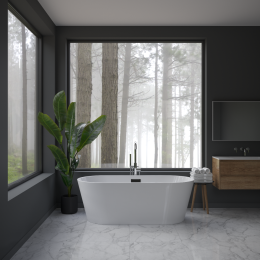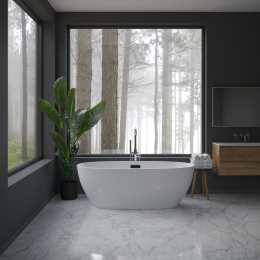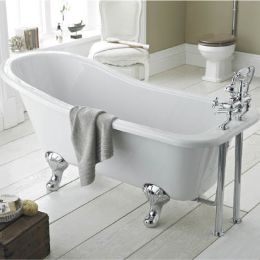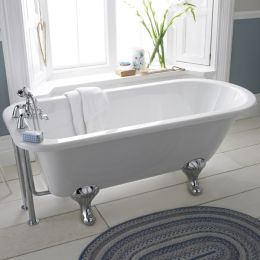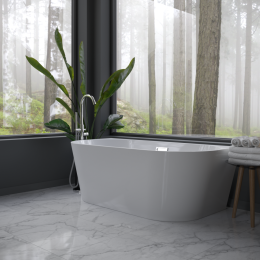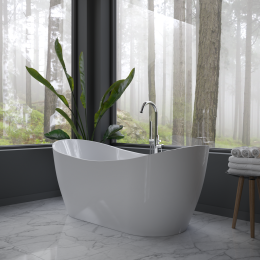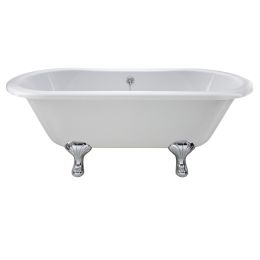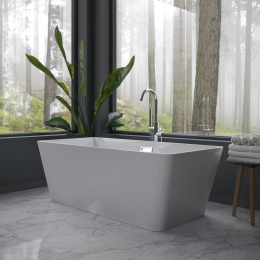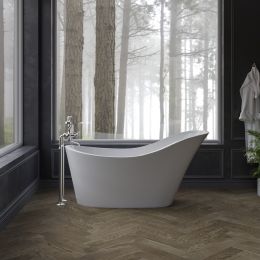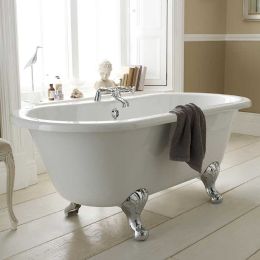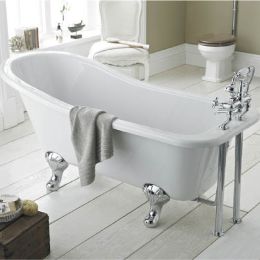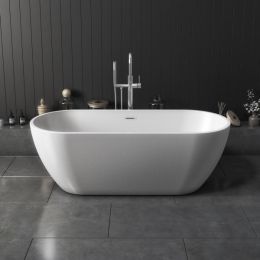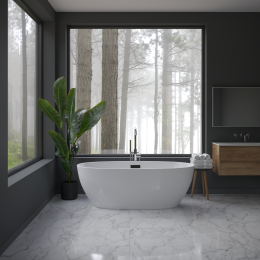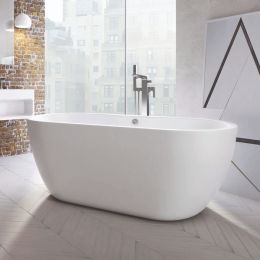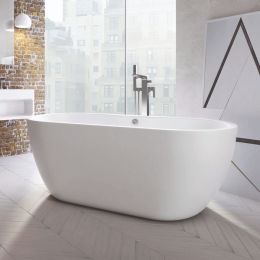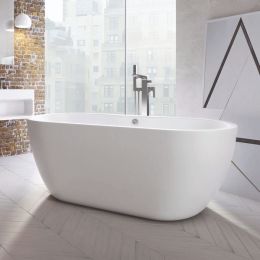While some freestanding baths may have a classic, vintage look, they’re still an extremely popular modern trend. Whether your bathroom is retro or contemporary, traditional freestanding baths could be the ideal solution for you.
Ideal for larger bathrooms, a freestanding bath is a great way to create a focal point and make a dramatic style statement, but even if you have a more compact space, small freestanding baths are now available so you can add that hint of glamour that you always wanted.
With this in mind, how do you know whether a freestanding bath is right for you? And what questions should you be asking to make the right decision? Here are our top tips in this in-depth buying guide.
What Is A Freestanding Bath?
Freestanding baths stand alone in a bathroom with no attachments to any supporting wall structures. Usually, they sit on the floor directly, but sometimes, they are mounted and have feet, which makes them an ideal eye-catching centrepiece in your bathroom design.
If you have a very large bathroom, your freestanding bath may be the ideal focal point with plenty of space on all sides. However, it’s still possible to create a spectacular showpiece in a smaller space thanks to the wide range of styles and sizes now available to choose from.
As you don’t need to tuck a freestanding bath in the corner of the room or place it against a wall like a regular tub, you can choose a structure for your bath that suits your needs best. Whether you’re looking for something shallow and narrow, or something wide and deep, there’s an option for you.
The Different Styles Of Freestanding Bath
Modern Freestanding Baths
While some freestanding baths are traditional in style, there are now many contemporary options that work perfectly in modern bathrooms. Unlike a classic freestanding bath, a contemporary model is straight-to-floor with no feet or legs.
Also, as there are both straight-line models and curving styles, you can find a modern freestanding bath to work perfectly with your bathroom’s décor.
Traditional Freestanding Baths
When you think of freestanding baths, you probably immediately conjure up images of a classic Victorian model. These traditional baths are still popular today and are wonderfully elegant and sophisticated.
With both double-ended and single-ended versions available, they’re a glamorous choice for your space, often featuring claw feet that raise the tub up from the floor instead of sitting flush on top of it.
Back To Wall Freestanding Bath
Back to wall freestanding baths, sometimes called BTW baths, are a kind of freestanding bath that has one straight edge so the tub can be placed against one wall. That allows you to locate your tub in many different ways, and it’s ideal if you have limited space or would prefer your bath to be kept to one side of the room.
Back to wall freestanding baths also give you more flexibility when it comes to choosing taps. There are lots of different styles of BTW bath out there to pick from, including square-edged, D-shaped, roll-top, and more, so you’re sure to find a model that’s right for you.
Roll Top Freestanding Baths
Roll top freestanding baths are one type of traditional design that feature a curving edge to the top of the rim. These baths have a true vintage look that exudes luxury and glamour.
Slipper Baths
Slipper baths make a strong statement in any bathroom thanks to their dramatic good looks. These freestanding baths feature either two raised ends or a single raised side, enabling you to enjoy a far deeper soak.
Thanks to their slipper-like shape, they were given their name, and it is this unique shape that gives the user extra support for their neck and back. If you have a small bathroom, a slipper bath could be ideal since it takes up less floor space than a standard bath. You can also find both traditional and contemporary versions to suit your taste.
What Are Freestanding Baths Made Of?
Something to consider when you choose a freestanding bath is the overall weight of the model. Depending on which material you choose, you could find your tub is very heavy and some floors are incapable of withstanding the weight. It’s therefore important to consider your tub material before you make a final choice.
There are many different materials to pick from, each with their own disadvantages and advantages. Here are some of the top choices.
Acrylic
If you want a lighter and lower cost option, an acrylic bathtub could be perfect. Durable, affordable, and versatile, and acrylic freestanding tub is lightweight and strong, so it can easily be carried and installed, even upstairs.
There is no need for any floor reinforcement either, so these tubs work in all properties. An acrylic tub has a comfortable, smooth surface and as the material is non-porous it resists discolouration, staining, and scratches effectively. There are lots of different shapes and sizes of acrylic freestanding tubs.
Corian/Solid Surface
A Corian solid surface tub is a premium choice that helps you create a dramatic and luxurious look for your home. Relatively low maintenance due to the virtually seam-free design, this type of tub is durable, strong, and long-lasting, while also boasting stunning good looks.
Steel/Copper /Cast Iron
There are some more unusual premium materials that freestanding baths may be made from. Steel, for example, is a contemporary choice boasting a thick porcelain enamel coating so they can retain a classic appearance while also being lighter weight.
Cast iron baths are extremely durable, but they are very heavy and can be costly to repair should they break. They do boast an impressive vintage appeal, though, and retain water heat well.
Copper baths also have a wonderfully retro look, but they can be hard to maintain.
Stone/Marble
If you’re seeking a super premium option for your bath, a stone or marble bath could be a perfect choice. Ideal for the most luxurious bathrooms, these costly materials look stunning but can be very heavy and so may not be ideal for an upstairs space.
Wood
Although wooden baths still exist, and boast plenty of retro appeal, they are not ideal for bathing! They look fantastic, and make a great focal point in your room, but they’re best reserved for people who want to look at their bath rather than actually use it.
Freestanding Bath Sizes
Freestanding baths come in several different sizes, so it’s easy to find one to fit in your space. Small freestanding baths are available for more compact homes, while larger models work perfectly in a spacious bathroom. It’s important to measure your space carefully if you’re considering a freestanding bathtub, and to bear in mind the feet and legs if you’re choosing a mounted, raised model.
Small Freestanding Baths
A small freestanding bath generally measures around 1500mm or 1600mm. They come in several configurations, so they work well in even a more compact space.
Large Freestanding Baths
You can find a freestanding bath as much as 1800mm in length, so you can really stretch out and enjoy a luxurious soak.
Standard Size Freestanding Baths
The most common size for a freestanding bath is 1700 x 750mm or 800mm. This size is ideal for most average bathrooms.
Where To Put A Freestanding Bath
When it comes to positioning your freestanding bath, the good news is that you have plenty of options, especially if you have a larger room. Some of your available options include:
- Central to bathroom – you can put your freestanding bath in the middle of your space if you wish, giving you lots of room to walk around it.
- Corner – you can buy corner freestanding baths that can be tucked up into a small space in the corner of your room to save on valuable floor space.
- Against the wall – with a back to wall freestanding bath, you can easily minimise the footprint of your bath by tucking it against the wall.
- Under or in front of a room feature – you can even choose to put your freestanding tub in front of your feature wall, a light, or a large picture window.
Remember to consider the pipework, though, both for the bath taps and the waste pipe. If you’re remodelling or building an entirely new bathroom, you can accommodate the waste and plumbing needs in the planning stage, but if you’re replacing an existing fixture, you need to consider the potential implications of moving your waste system.
Freestanding bath installations have a waste system that is housed under the floor level, which is different from a regular bath fitting with a waste system under the bath. This needs to be taken into account when making your purchasing decision.
Where Do The Taps Go?
Freestanding baths give you more freedom for placing the taps. You can choose from the following placements:
- Freestanding taps – these taps are a perfect complement to a freestanding tub with both modern and traditional designs available. As they are freestanding, they can be placed virtually anywhere and that gives you a lot of flexibility when positioning the bath as well as the taps themselves.
It’s also possible to choose a freestanding bath shower mixer. If you’re opting for this type of tap, you need to be sure you’ve got sufficient space to place them so that nobody will be inconvenienced by their placement. Ensure they’re well away from the toilet, sink, and bathroom door.
- Wall-mounted taps – if your freestanding bath is being positioned by the wall, or you’re choosing a back to wall tub, you’ll probably need wall-mounted taps.
Mounted onto the wall, these taps have a spout that is positioned over the tub. These taps are great for hiding pipes as they are tucked away cleverly in the wall.
- Deck mounted taps – not all baths are suitable for deck mounted taps. Fitted onto the bath edge itself, these are traditionally styled taps and are very practical and functional. You can only opt for this type of tap if the tub comes with pre-drilled holes for the taps.
There are several styles of deck mounted tap available including separate traditional or modern taps, lever-handled designs, or bath shower mixers.
Usually, there are two different options when it comes to placing taps on freestanding baths – at one end, or in the centre of the tub. If you’ve chosen a double-ended bath, positioning the taps, even if they’re wall-mounted or deck-mounted should be located in the middle of the tub.
If you’ve chosen a slipper bath with one raised end, the taps are best positioned at the shallower end of the tub so you can lounge comfortably with the support of the deeper end.
If you’ve opted for freestanding taps, the stand separately from the tub itself, so it’s possible to place them in almost any location. If you install them right by the bath, they’ll be positioned for the water to flow out into either the centre of the tub or at the end.
What Do I Need To Consider?
There are several considerations to bear in mind when choosing a freestanding tub. Here are a few of the top things to consider:
Freestanding taps are more costly than other types of tap, so if you’re on a tight budget you may wish to forgo this option.
It can be generally quite impractical and even difficult to use a freestanding bath for showering unless you opt for a back to wall or corner bath.
Space is always going to be a consideration with freestanding baths, especially if you want a central location in the room. Make sure to measure accurately before making your purchasing decision.
Will you be placing your bath against a wall? If so, will you be looking for a back to wall freestanding bath? And what type of taps will you be considering?
If you’re keen to choose a bath that has feet you will have exposed waste and tap connections, so you’ll need to consider their appearance.
Common Questions Answered
Can I put a shower over a freestanding bath?
You can only fit a shower over a traditional corner freestanding bath as it would be too difficult to stop the water from going everywhere if you have a centrally positioned tub.
How much is a freestanding bath likely to cost?
Depending on the model and material you choose, your freestanding bath could cost anything from as little as £400 right up to £25,000 or even more!
Is a freestanding bath stable?
Stability isn’t an issue with a freestanding bath as long as it is fitted correctly.
How much does a freestanding bath weigh? An acrylic freestanding bath will weigh somewhere between 60kg and 90kg, but a solid surface bath could weigh considerably more than that, even as much as 300kg.
What Else Do I Need?
When you’re buying a freestanding bath, you don’t just have to consider the bath itself but also the other accessories and fittings to go with it. For example, you need to consider which type of taps to choose and whether the waste connections will be exposed or build into the bath.
You may also want to consider whether it’s possible to fit the tub yourself if you’re hoping to save money on your bath installation, although we always recommend that you get a professional to help you with this to avoid any costly mistakes.


